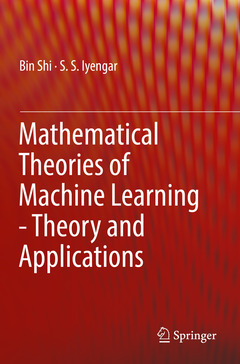Description
Mathematical Theories of Machine Learning - Theory and Applications, 1st ed. 2020
Authors: Shi Bin, Iyengar S. S.
Language: English
Subjects for Mathematical Theories of Machine Learning - Theory and...:
Approximative price 91.77 €
In Print (Delivery period: 15 days).
Add to cartPublication date: 08-2020
Support: Print on demand
Approximative price 91.77 €
In Print (Delivery period: 15 days).
Add to cartPublication date: 06-2019
133 p. · 15.5x23.5 cm · Hardback
Description
/li>Contents
/li>Biography
/li>Comment
/li>
This book studies mathematical theories of machine learning. The first part of the book explores the optimality and adaptivity of choosing step sizes of gradient descent for escaping strict saddle points in non-convex optimization problems. In the second part, the authors propose algorithms to find local minima in nonconvex optimization and to obtain global minima in some degree from the Newton Second Law without friction. In the third part, the authors study the problem of subspace clustering with noisy and missing data, which is a problem well-motivated by practical applications data subject to stochastic Gaussian noise and/or incomplete data with uniformly missing entries. In the last part, the authors introduce an novel VAR model with Elastic-Net regularization and its equivalent Bayesian model allowing for both a stable sparsity and a group selection.
Chapter 1. Introduction.- Chapter 2. General Framework of Mathematics.- Chapter 3. Problem Formulation.- Chapter 4. Development of Novel Techniques of CoCoSSC Method.- Chapter 5. Further Discussions of the Proposed Method.- Chapter 6. Related Work on Geometry of Non-Convex Programs.- Chapter 7. Gradient Descent Converges to Minimizers.- Chapter 8. A Conservation Law Method Based on Optimization.- Chapter 9. Improved Sample Complexity in Sparse Subspace Clustering with Noisy and Missing Observations.- Chapter 10. Online Discovery for Stable and Grouping Causalities in Multi-Variate Time Series.- Chapter 11. Conclusion.
Dr. S.S. Iyengar is the Distinguished University Professor, Ryder Professor of Computer Science and Director of the School of Computing and Information Sciences at Florida International University (FIU), Miami. He is also the founding director of the Discovery Lab. Prior to joining FIU, Dr. Iyengar was the Roy Paul Daniel's Distinguished Professor and Chairman of the Computer Science department for over 20 years at Lousiana State University. He has also worked as a visiting scientist at Oak Ridge National Lab, Jet Propulsion Lab, Satish Dhawan Professor at IISc and Homi Bhabha Professor at IGCAR, Kalpakkam and University of Paris and visited Tsinghua University, Korea Advanced Institute of Science and Technology (KAIST) etc. Professor Iyengar is an IEEE Distinguished Visitor, SIAM Distinguished Lecturer, and ACM National Lecturer and has won many other awards like Distinguished Research Master's award, Hub Cotton award of Faculty Excellence (LSU), Rain Maker awards (LSU), Florida Information Technology award (IT2), Distinguished Research award from Tunisian Mathematical Society etc. During the last four decades, he has supervised over 55 Ph.D. students, 100 Master's students, and many undergraduate students who are now faculty at Major Universities worldwide or Scientists or Engineers at National Labs/Industries around the world. He has published
Provides a thorough look into the variety of mathematical theories of machine learning
Presented in four parts, allowing for readers to easily navigate the complex theories
Includes extensive empirical studies on both the synthetic and real application time series data




